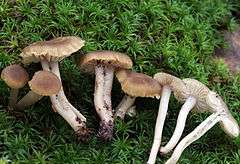Camarophyllopsis
Camarophyllopsis is a genus of 26 species of fungi with a widespread distribution, especially in northern temperate areas.[3] Members of Camarophyllopsis are distinguished from members of the family Hygrophoraceae mainly by their hymenoderm pileipellis. The arrangement of lamellar trama is highly variable between species. Coloration of the fruit body is dull, tending toward browns and grays. Many members of this genus were formerly classified in the genus Hygrotrama, but the two genera were subsequently put in synonymy.[1]
| Camarophyllopsis | |
|---|---|
 | |
| Camarophyllopsis sp. | |
| Scientific classification | |
| Kingdom: | |
| Division: | |
| Class: | |
| Order: | |
| Family: | |
| Genus: | Camarophyllopsis Herink (1958) |
| Type species | |
| Camarophyllopsis schulzeri (Bres.) Herink (1958) | |
| Synonyms[1] | |
Taxonomy
Camarophyllopsis was circumscribed by Czech mycologist Josef Herink in 1958, with Hygrophorus schulzeri as the type and only species.[4] Roger Heim had the year previously treated this group of species under the name Hodophilus,[5] but this was invalid because he did not include a Latin diagnosis for the genus, as was required by the rules of botanical nomenclature at the time.[6] Rolf Singer published Hygrotrama in March 1959 (with type species Hygrotrama dennisianum),[2] and Heim later (1966) published the name Hodophilus validly (type species H. foetens).[7] Since Camarophyllopsis was published earlier than either of these competing names, it has priority.[6]
Eef Arnolds proposed an infrageneric classification of Camarophyllopsis consisting of two subgenera differentiated by the structure of the cap cuticle (pileipellis). Subgenus Camarophyllis contained species with a trichodermium pileipellis (with hyphae arranged perpendicularly to the cap surface), while species in subgenus Hygrotrama had a hymeniderm pileipellis (with a structure similar to that of the hymenium). Arnolds further split the latter subgenus into two sections: sect. Hygrotrama (with clamp connections), and sect. Hodophilus (without clamp connections).[6]
Previously placed in the family Hygrophoraceae based on its morphology,[6][8][9] Camarophyllopsis was shown using molecular phylogenetics to belong in the Clavariaceae.[10]
Species
- Camarophyllopsis albipes (Singer) Boertm. 2002 – Mexico[9]
- Camarophyllopsis albofloccipes Kovalenko, E.F.Malysheva & O.V.Morozova 2012 – Russia[11]
- Camarophyllopsis araguensis (Singer) Boertm. 2002 – South America[9]
- Camarophyllopsis atropuncta (Pers.) Arnolds 1986
- Camarophyllopsis atrovelutina (Romagn.) Argaud 2002[12]
- Camarophyllopsis darwinensis A.M.Young 1997 – Australia[13]
- Camarophyllopsis dennisiana (Singer) Arnolds 1986
- Camarophyllopsis foetens (W.Phillips) Arnolds 1986 – Europe; has an intense mothball odor
- Camarophyllopsis hiemalis (Singer & Clémençon) Arnolds 1986 – Europe
- Camarophyllopsis hymenocephala (A.H.Sm. & Hesler) Arnolds 1986
- Camarophyllopsis kearneyi A.M.Young 1999 – New South Wales, Australia[14]
- Camarophyllopsis lacunaris Bizio & Contu 2004 – Italy[15]
- Camarophyllopsis leucopus (Singer) Boertm. 2002 – South America[9]
- Camarophyllopsis micacea (Berk. & Broome) Arnolds 1987[16]
- Camarophyllopsis microspora (A.H.Sm. & Hesler) Bon 1996[17]
- Camarophyllopsis paupertina (A.H.Sm. & Hesler) Boertm. 2002[9]
- Camarophyllopsis peckiana (Howe) Boertm. 2002[9]
- Camarophyllopsis pedicellata (Natarajan & Manjula) Boertm. 2002 – Tamil Nadu, India[9]
- Camarophyllopsis phaeophylla (Romagn.) Arnolds 1986 – Europe
- Camarophyllopsis phaeoxantha (Romagn.) Arnolds 1986 – Europe
- Camarophyllopsis roseola (G.Stev.) Boertm. 2002[9]
- Camarophyllopsis rugulosa (A.H.Sm. & Hesler) Arnolds 1986
- Camarophyllopsis rugulosoides (Hesler & A.H.Sm.) Boertm. 2002[9]
- Camarophyllopsis schulzeri (Bres.) Herink 1958
- Camarophyllopsis subfuscescens (A.H.Sm. & Hesler) Arnolds 1986
- Camarophyllopsis tetraspora (Singer) Raithelh. 1992 – South America[18]
See also
References
- "Synonymy: Camarophyllopsis Herink". Species Fungorum. CAB International. Retrieved 2014-11-16.
- Singer R. (1958). "Fungi Mexicani, series secunda – Agaricales". Sydowia. 12 (1–6): 221–43.
- Kirk PM, Cannon PF, Minter DW, Stalpers JA (2008). Dictionary of the Fungi (10th ed.). Wallingford, UK: CAB International. p. 113. ISBN 0-85199-826-7.
- Herink J. (1958). "Stavnatkovité houby parhorku "Velká Horka" u Mnichova Hradiste". Sborník Severoceského Musea (in Czech). 1: 53–86.
- Heim R. (1957). Les Champignons d'Europe (in French). Paris, France: N. Boubée. p. 196.
- Arnolds E. (1986). "Notes on Hygrophoraceae IX. Camarophyllopsis Herink, an older name for Hygrotrama Sing". Mycotaxon. 25: 639–644.
- Heim R. (1966). "Breves diagnoses latinae novitatum genericarum specificarumque nuper descriptarum". Revue de Mycologie. 30: 231–241.
- Helser LR, Smith AH (1963). North American species of Hygrophorus. Knoxville, USA: University of Tennessee Press. p. 2.
- Boertmann D. (2002). Index Hygrocybearum. A catalogue to names and potential names in tribus Hygrocybeae Kühner (Tricholomatales, Fungi). Bibliotheca Mycologica. 192. Stuttgart, Germany: J. Cramer. ISBN 978-3443590949.
- Matheny PB, Curtis JM, Hofstetter V, Aime MC, Moncalvo JM, Ge ZW, Slot JC, Ammirati JF, Baroni TJ, Bougher NL, Hughes KW, Lodge DJ, Kerrigan RW, Seidl MT, Aanen DK, DeNitis M, Daniele GM, Desjardin DE, Kropp BR, Norvell LL, Parker A, Vellinga EC, Vilgalys R, Hibbett DS (2006). "Major clades of Agaricales: a multilocus phylogenetic overview" (PDF). Mycologia. 98 (6): 982–95. doi:10.3852/mycologia.98.6.982. PMID 17486974. Archived from the original (PDF) on 2016-03-03.
- Kovalenko AE, Malysheva EF, Morozova OV (2012). "The genus Camarophyllopsis in Russia: new records and new species C. albofloccipes". Mycologiya i Fitopatologiya. 46 (1): 54–6.
- Argaud D. (2002). "Gerronema atrovelutinum: complément d'étude et position systématique (= Camarophyllopsis atrovelutina comb. nov.)". Documents Mycologiques (in French). 31 (123): 41–50.
- Young AM. (1997). "Studies on the Hygrophoraceae (Fungi, Homobasidiomycetes, Agaricales) of Australia". Australian Systematic Botany. 10 (6): 911–1030. doi:10.1071/SB96005.
- Young AM. (1999). "The Hygrocybeae of Lane Cove Bushland Park, New South Wales". Austrobaileya. 5: 535–64.
- Bizio E, Contu M (2004). "Camarophyllopsis lacunaris spec. nov. Una nuova specie dalla Laguna di Venezia". Revista di Micologia (in Italian). 1: 25–34.
- Arnolds E. (1987). "Notes on Hygrophoraceae X. Three new combinations in Hygrophoraceae". Persoonia. 13 (3): 386.
- Bon M. (1996). "Novitates". Documents Mycologiques (in French). 26 (103): 19–20.
- Raithelhuber J. (1992). "Agaric flora of South America". Metrodiana. 19 (1): 5–47.